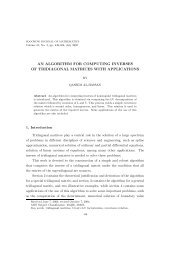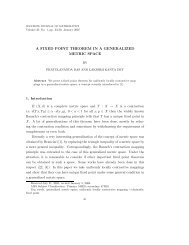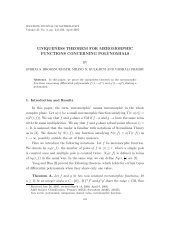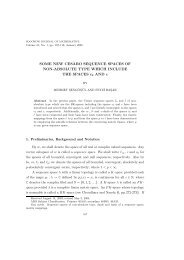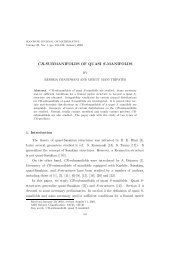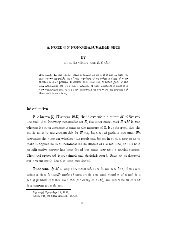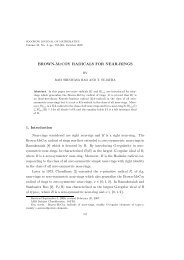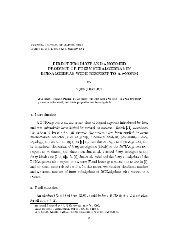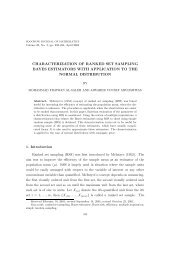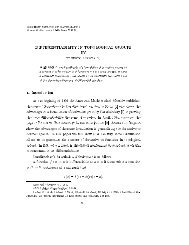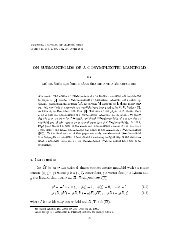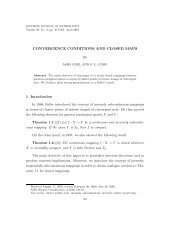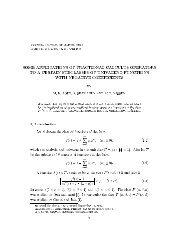intuitionistic m-fuzzy groups - Soochow Journal of Mathematics
intuitionistic m-fuzzy groups - Soochow Journal of Mathematics
intuitionistic m-fuzzy groups - Soochow Journal of Mathematics
You also want an ePaper? Increase the reach of your titles
YUMPU automatically turns print PDFs into web optimized ePapers that Google loves.
SOOCHOW JOURNAL OF MATHEMATICS<br />
Volume 30, No. 1, pp. 85-90, January 2004<br />
INTUITIONISTIC M-FUZZY GROUPS<br />
BY<br />
JIANMING ZHAN AND ZHISONG TAN<br />
Abstract. In this paper, we introduce the concept <strong>of</strong> <strong>intuitionistic</strong> M-<strong>fuzzy</strong> <strong>groups</strong><br />
and obtain some results.<br />
1. Introduction and Preliminaries<br />
After the introduction <strong>of</strong> the concept <strong>of</strong> <strong>fuzzy</strong> sets by Zadeh, several researches<br />
were conducted on the generalizations <strong>of</strong> the notion <strong>of</strong> <strong>fuzzy</strong> sets. The<br />
idea <strong>of</strong> “<strong>intuitionistic</strong> <strong>fuzzy</strong> set” was first published by Atanassov[1,2], as a generalization<br />
<strong>of</strong> the notion <strong>of</strong> <strong>fuzzy</strong> sets. Rosenfeld[7] introduced the concept <strong>of</strong> a<br />
<strong>fuzzy</strong> group and Wu[6] studied the <strong>fuzzy</strong> normal subgroup. Gu[3] put forward the<br />
notion <strong>of</strong> the <strong>fuzzy</strong> <strong>groups</strong> with operators. In this paper, we introduce the concept<br />
<strong>of</strong> <strong>intuitionistic</strong> <strong>fuzzy</strong> group with operators and obtain some related results.<br />
For the sake <strong>of</strong> convenience, we set out the former concepts.<br />
Definition 1.1.([7]) A <strong>fuzzy</strong> set A <strong>of</strong> a group G is called a <strong>fuzzy</strong> subgroup<br />
if (1) A(xy) ≥ A(x) ∧ A(y); (2) A(x −1 ) ≥ A(x) for all x, y ∈ G.<br />
Definition 1.2.([4]) A group with operators is an algebraic system consisting<br />
<strong>of</strong> a group G ,asetM and a function defined in the product set M × G and<br />
having values in G such that, if ma denotes the element in G determined by the<br />
element a <strong>of</strong> G and the element m <strong>of</strong> M, thenm(ab) =(ma)(mb) holdsforall<br />
a, b ∈ G and m ∈ M. We shall use the phrases “G is an M-group” to a group<br />
with operators.<br />
Received February 25, 2003; revised May 22, 2003.<br />
AMS Subject Classification. 22F05, 06F10, 03E72, 04A72.<br />
Key words. <strong>intuitionistic</strong> M-<strong>fuzzy</strong> <strong>groups</strong>, homomorphism, M-homomorphism.<br />
85
86 JIANMING ZHAN AND ZHISONG TAN<br />
Definition 1.3.([4]) A subgroup A <strong>of</strong> an M-group G is said to be an M-<br />
subgroup if mx ∈ A for all m ∈ M and x ∈ A.<br />
Definition 1.4.([4]) Let G and G ′ be M-<strong>groups</strong>, f be a homomorphism from<br />
G onto G ′ . If f(mx) =mf(x) for all m ∈ M and x ∈ G, thenf is called an<br />
M-homomorphism.<br />
An <strong>intuitionistic</strong> <strong>fuzzy</strong> set (briefly, IFS) A in a nonempty set X is an object<br />
having the form<br />
A = {(x, α A (x),β A (x))|x ∈ X}<br />
where the functions α A : X → [0, 1] and β A : X → [0, 1] denote the degree <strong>of</strong><br />
membership and the degree <strong>of</strong> nonmembership, respectively, and<br />
0 ≤ α A (x)+β A (x) ≤ 1, ∀x ∈ X.<br />
An <strong>intuitionistic</strong> <strong>fuzzy</strong> set A = {(x, α A (x),β A (x))|x ∈ X} in X can be identified<br />
to an ordered pair (α A ,β A )inI X × I X . For the sake <strong>of</strong> simplicity, we shall use<br />
the symbol A =(α A ,β A )fortheIFS A = {(x, α A (x),β A (x))|x ∈ X}.<br />
2. Intuitionistic M-Fuzzy Sub<strong>groups</strong><br />
Definition 2.1. An IFS A=(α A ,β A ) in a group G is called an <strong>intuitionistic</strong><br />
<strong>fuzzy</strong> subgroup <strong>of</strong> G if<br />
(i) α A (xy) ≥ α A (x) ∧ α A (y) andβ A (xy) ≤ β A (x) ∨ β A (y)<br />
(ii) α A (x −1 ) ≥ α A (x) andβ A (x −1 ) ≤ β A (x)<br />
for all x, y ∈ G.<br />
Definition 2.2. Let G be an M-group and IFS A=(α A ,β A )bean<strong>intuitionistic</strong><br />
<strong>fuzzy</strong> subgroup <strong>of</strong> G. If α A (mx) ≥ α A (x) andβ A (mx) ≤ β A (x) for all<br />
x ∈ G and m ∈ M, thenIFS A=(α A ,β A )issaidtobean<strong>intuitionistic</strong><strong>fuzzy</strong><br />
subgroup with operators <strong>of</strong> G. We use the phrase “A =(α A ,β A )isan<strong>intuitionistic</strong><br />
M-<strong>fuzzy</strong> subgroup <strong>of</strong> G” instead <strong>of</strong> an <strong>intuitionistic</strong> <strong>fuzzy</strong> subgroup with<br />
operators <strong>of</strong> G.<br />
Example 2.3. Let A be an M-subgroup <strong>of</strong> an M-group G and let IFS<br />
A=(α A ,β A ) be an <strong>intuitionistic</strong> <strong>fuzzy</strong> set in G defined by<br />
⎧<br />
⎧<br />
⎨0.7 if x ∈ A<br />
⎨0.2 if x ∈ A<br />
α A (x) =<br />
β<br />
⎩<br />
A (x) =<br />
0.2 otherwise<br />
⎩<br />
0.6 otherwise
INTUITIONISTIC M-FUZZY GROUPS 87<br />
for all x ∈ X. Then it is easy to verify that IFS A=(α A ,β A ) is an <strong>intuitionistic</strong><br />
M-<strong>fuzzy</strong> subgroup <strong>of</strong> G.<br />
Example 2.4. Let G be an M-group while A is a nonempty subset <strong>of</strong><br />
G. If χ A is the characteristic function <strong>of</strong> A, thenA is an M-subgroup <strong>of</strong> G if<br />
and only if IFS A=(χ A , χ A ) is an <strong>intuitionistic</strong> M-<strong>fuzzy</strong> subgroup <strong>of</strong> G, where<br />
χ A (x) =1− χ A (x) for all x ∈ G.<br />
Proposition 2.5. If IFS A=(α A ,β A ) is an <strong>intuitionistic</strong> M-<strong>fuzzy</strong> subgroup<br />
<strong>of</strong> an M-group G, then for any x, y ∈ G and m ∈ M.<br />
(i) α A (m(xy)) ≥ α A (mx) ∧ α A (my) and β A (m(xy)) ≤ β A (mx) ∨ β A (my)<br />
(ii) α A (mx −1 ) ≥ α A (x) and β A (mx −1 ) ≤ β A (x).<br />
Theorem 2.6. Let A be an M-subgroup <strong>of</strong> an M-group G and let IFS<br />
A=(α A ,β A ) be an <strong>intuitionistic</strong> <strong>fuzzy</strong> set in G defined by<br />
⎧<br />
⎨<br />
α A (x) =<br />
⎩<br />
t 1<br />
t 2<br />
⎧<br />
if x ∈ A<br />
⎨s 1 if x ∈ A<br />
β A (x) =<br />
otherwise<br />
⎩<br />
otherwise<br />
for all x ∈ X, t 1 > t 2 and s 1 < s 2 in [0, 1]. Then IFS A=(α A ,β A ) is an<br />
<strong>intuitionistic</strong> M-<strong>fuzzy</strong> subgroup <strong>of</strong> G.<br />
Pro<strong>of</strong>. Assume that A is an M-subgroup <strong>of</strong> G. Letx, y ∈ G. Ifx and y are<br />
in A, thenα A (x) =t 1 = α A (y) andxy ∈ A. Hence α A (xy) =t 1 = α A (x)∧α A (y).<br />
If either x ∉ A or y ∉ A, then either α A (x) =t 2 or α A (y) =t 2 . It follows that<br />
α A (x∗y) ≥ t 2 ≥ α A (x)∧α A (y). Similarly, we have β A (x∗y) ≤ β(x)∨β A (y). Now,<br />
let x ∈ G. Ifx ∈ A, thenα A (x) =t 1 and x −1 ∈ A. Thusα A (x) =t 1 = α A (x −1 ).<br />
If x ∉ A, thenα A (x) =t 2 and x −1 ∉ A. Thusα A (x −1 )=t 2 = α A (x). Similarly,<br />
we have β A (x −1 )=β A (x). Hence IFS A=(α A ,β A ) is an <strong>intuitionistic</strong> <strong>fuzzy</strong><br />
subgroup <strong>of</strong> G. Since A is an M-subgroup <strong>of</strong> G, wehavemx ∈ A for all x ∈ A<br />
and m ∈ M. Therefore α A (mx) =t 1 = α A (x) andβ A (mx) =s 1 = β A (x). If<br />
x ∉ A, thenα A (mx) ≥ t 2 = α A (x) andβ A (mx) ≤ s 2 = β A (x). Consequently,<br />
IFS A=(α A ,β A ) is an <strong>intuitionistic</strong> M-<strong>fuzzy</strong> subgroup <strong>of</strong> G. This completes the<br />
pro<strong>of</strong>.<br />
For any α ∈ [0, 1], the set U(α A ; α) ={x ∈ G|α A (x) ≥ α} (resp. L(α A ; α) =<br />
{x ∈ G|α A (x) ≤ α}) is called an upper (resp. lower) α -level cut <strong>of</strong> α A .<br />
s 2
88 JIANMING ZHAN AND ZHISONG TAN<br />
Theorem 2.7. Let IFS A=(α A ,β A ) be an IFS in an M-group G. ThenIFS<br />
A=(α A ,β A ) is an <strong>intuitionistic</strong> M-<strong>fuzzy</strong> subgroup <strong>of</strong> G if and only if the nonempty<br />
sets U(α A ; α) and L(β A ; α) are M-sub<strong>groups</strong> <strong>of</strong> G for every α ∈ Imα A ∩ Imβ A .<br />
Pro<strong>of</strong>. Let α ∈ Imα A ∩Imβ A ⊆ [0, 1] and x, y ∈ U(α A ; α). Then α A (x) ≥ α<br />
and β A (y) ≥ α. It follows that α A (xy) ≥ α A (x) ∧ α A (y) ≥ α, sothatxy ∈<br />
U(α A ; α). Moreover, if x ∈ U(α A ; α), then α A (x) ≥ α. It follows that α A (x −1 ) ≥<br />
α A (x) ≥ α, and that x −1 ∈ U(α A ; α). Hence U(α A ; α) is a subgroup <strong>of</strong> G.<br />
Now, let x, y ∈ L(β A ; α), then β A (x) ≤ α and β A (y) ≤ α. It follows that<br />
β A (xy) ≤ β A (x) ∨ β A (y) ≤ α, andthatxy ∈ L(β A ; α). Moreover, if x ∈ L(β A ; α),<br />
then β A (x) ≤ α. It follows that β A (x −1 ) ≤ β A (x) ≤ α, andthatx −1 ∈ L(β A ; α).<br />
Hence L(β A ; α) is a subgroup <strong>of</strong> G. For any x ∈ U(α A ; α) andm ∈ M, wehave<br />
α A (mx) ≥ α A (x) ≥ α, andthatmx ∈ U(α A ; α). If x ∈ L(β A ; α) andm ∈ M,<br />
we have β A (mx) ≤ β A (x) ≤ α ,andthatmx ∈ L(β A ; α). Thus U(α A ; α) and<br />
L(β A ; α) areM-sub<strong>groups</strong> <strong>of</strong> G.<br />
Conversely, assume that the nonempty sets U(α A ; α) andL(β A ; α) areMsub<strong>groups</strong><br />
<strong>of</strong> G. Ifthereexistx 0 ,y 0 ∈ G such that α A (x 0 y 0 )
INTUITIONISTIC M-FUZZY GROUPS 89<br />
Lemma 2.8. Let G and G ′ be M-<strong>groups</strong> and f a homomorphism from G<br />
onto G ′ .<br />
(1) If IFS A=(α A ,β A ) is an <strong>intuitionistic</strong> <strong>fuzzy</strong> subgroup <strong>of</strong> G ′ ,thenIFS A f =<br />
(α f A ,βf A<br />
) is an <strong>intuitionistic</strong> <strong>fuzzy</strong> subgroup <strong>of</strong> G.<br />
(2) If IFS A f =(α f A ,βf A<br />
) is an <strong>intuitionistic</strong> <strong>fuzzy</strong> subgroup <strong>of</strong> G, thenIFS<br />
A=(α A ,β A ) is an <strong>intuitionistic</strong> <strong>fuzzy</strong> subgroup <strong>of</strong> G ′ .<br />
Pro<strong>of</strong>. (1) Let x, y ∈ G, wehave<br />
α f A (xy) =α A(f(xy)) = α A (f(x)f(y)) ≥ α A (f(x)) ∧ α A (f(y)) = α f A (x) ∧ αf A (y)<br />
β f A (xy) =β A(f(xy)) = β A (f(x)f(y)) ≤ β A (f(x)) ∨ β A (f(y)) = β f A (x) ∨ βf A (y)<br />
α f A (x−1 )=α A (f(x −1 )) = α A (f(x) −1 ) ≥ α A (f(x)) = α f A (x)<br />
β f A (x−1 )=β A (f(x −1 )) = β A (f(x) −1 ) ≤ β A (f(x)) = β f A (x).<br />
Hence IFS A f =(α f A ,βf A<br />
) is an <strong>intuitionistic</strong> <strong>fuzzy</strong> subgroup <strong>of</strong> G.<br />
(2) For any x, y ∈ G ′ ,thereexista, b ∈ G such that f(a) =x and f(b) =y.<br />
α A (xy) =α A (f(a)f(b)) = α A (f(ab)) = α f A (ab) ≥ αf A (a) ∧ αf A (b) =α A(f(a)) ∧<br />
α A (f(b)) = α A (x) ∧ α A (y); β A (xy) =β A (f(a)f(b)) = β A (f(ab)) = β f A (ab) ≤<br />
β f A (a) ∨ βf A (b) =β A(f(a)) ∨ β A (f(b)) = β A (x) ∨ β A (y); α A (x −1 )=α A (f(a) −1 )=<br />
α A (f(a −1 )) = α f A (a−1 ) ≥ α f A (a)=α A(f(a))=α A (x) andβ A (x −1 )=β A (f(a) −1 )=<br />
β A (f(a −1 )) = β f A (a−1 ) ≤ β f A (a) =β A(f(a)) = β A (x). Hence IFS A=(α A ,β A )is<br />
an <strong>intuitionistic</strong> <strong>fuzzy</strong> subgroup <strong>of</strong> G ′ .<br />
Theorem 2.9. Let G and G ′ be M-<strong>groups</strong> and f an M-homomorphism from<br />
G onto G ′ .IfIFS A=(α A ,β A ) is an <strong>intuitionistic</strong> M-<strong>fuzzy</strong> subgroup <strong>of</strong> G ′ ,then<br />
IFS A f =(α f A ,βf A<br />
) is an <strong>intuitionistic</strong> M-<strong>fuzzy</strong> subgroup <strong>of</strong> G.<br />
Pro<strong>of</strong>. By Lemma 2.8, IFS A f =(α f A ,βf A<br />
) is an <strong>intuitionistic</strong> <strong>fuzzy</strong> subgroup<br />
<strong>of</strong> G. For any x ∈ G and m ∈ M,<br />
α f A (mx)=α A(f(mx)) = α A (mf(x)) ≥ α A (f(x)) = α f A (x);<br />
β f A (mx)=β A(f(mx)) = β A (mf(x)) ≤ β A (f(x)) = β f A (x).<br />
Hence IFS A f =(α f A ,βf A<br />
) is an <strong>intuitionistic</strong> M-<strong>fuzzy</strong> subgroup <strong>of</strong> G.
90 JIANMING ZHAN AND ZHISONG TAN<br />
Theorem 2.10. Let G and G ′ be M-<strong>groups</strong> and f an M-homomorphism<br />
from G onto G ′ .IfIFS A f =(α f A ,βf A<br />
) is an <strong>intuitionistic</strong> M-<strong>fuzzy</strong> subgroup <strong>of</strong><br />
G, thenIFS A=(α A ,β A ) is an <strong>intuitionistic</strong> M-<strong>fuzzy</strong> subgroup <strong>of</strong> G ′ .<br />
Pro<strong>of</strong>. By Lemma 2.8, IFS A=(α A ,β A ) is an <strong>intuitionistic</strong> <strong>fuzzy</strong> subgroup<br />
<strong>of</strong> G ′ . For any y ∈ G ′ and m ∈ M,<br />
α f A (my)=<br />
and<br />
β f A (my)=<br />
sup α A (z) ≥ sup α A (mx) (wherex ∈ f −1 (y))<br />
z∈f −1 (my)<br />
mx∈f −1 (my)<br />
= sup α A (mx) =<br />
f(mx)=my<br />
inf β A(z) ≤<br />
z∈f −1 (my)<br />
= inf<br />
f(mx)=my β A(mx) =<br />
sup α A (mx) ≥<br />
mf(x)=my<br />
inf β A(mx)<br />
mx∈f −1 (my)<br />
inf β A(mx) ≤<br />
mf(x)=my<br />
sup α A (x) =α f A (y)<br />
f(x)=y<br />
(where x ∈ f −1 (y))<br />
inf β A(x) =β f A (y).<br />
f(x)=y<br />
Hence IFS A=(α A ,β A ) is an <strong>intuitionistic</strong> M-<strong>fuzzy</strong> subgroup <strong>of</strong> G ′ .<br />
Acknowledgments<br />
The authors are very grateful to the referees for their advice.<br />
References<br />
[1] K.T.Atanassov,Intuitionistic <strong>fuzzy</strong> sets, Fuzzy Sets and Systems, 20(1986), 87-96.<br />
[2] K. T. Atanassov, New operations defined over the <strong>intuitionistic</strong> <strong>fuzzy</strong> sets, Fuzzy Sets and<br />
Systems, 61(1994), 137-142.<br />
[3] W.X.Gu,S.Y.LiandD.G.Chen,Fuzzy <strong>groups</strong> with operators, Fuzzy Sets and Systems,<br />
66 (1994), 363-371.<br />
[4] N. Jacobson, Lectures in Abstract Algebras, East-West Press, 1951.<br />
[5] Y.B.Jun,Fuzzy BCK/BCI-algebras with operators, Sci. Math., 3(2000), 283-287.<br />
[6] W.M.Wu,Normal <strong>fuzzy</strong> sub<strong>groups</strong>, Fuzzy Math., 1 (1981), 21-23.<br />
[7] A. Rosenfeld, Fuzzy <strong>groups</strong>, J. Math. Anal. Appl., 35(1971), 512-517.<br />
[8] L.A.Zadeh,Fuzzy sets, Inform. & Control, 8(1965), 338-353.<br />
Department <strong>of</strong> <strong>Mathematics</strong>, Hubei Institute for Nationalities, Enshi, Hubei Province, 445000,<br />
P.R. China.<br />
E-mail: zhanjianming@hotmail.com



